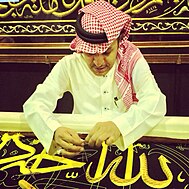Kiswah
The kiswa (Arabic: كسوة الكعبة, kiswat al-ka'bah) is the cloth that covers the Kaaba in Mecca, Saudi Arabia.
Due to the iconic designs and the quality of materials used in creating the kiswa, it is considered one of the most sacred objects in Islamic art, ritual, and worship.
[3] According to Ibn Hisham, King Tubba Abu Karib As'ad of the Himyarite Kingdom, who would later become a revered figure in Islamic traditions, clothed Kaaba for the first time during the rule of the Jurhum tribe of Mecca in the early fifth century CE after learning about it from two Jewish rabbis after his conversion to Judaism.
[4] Muhammad and the Muslims in Mecca did not participate in the draping of the Kaaba until the conquest of the city at 630 AD (7 AH), as the ruling tribe, Quraish, did not allow them to do so.
Muhammad’s successors would continue the tradition of draping the kiswa, with Umar al-Khattab (Arabic: عمر بن الخطاب) being the first caliph to send an Egyptian kiswa made out of a white linen known as qubati (Arabic: قُبْطِيّ), a type of embroidered linen manufactured by Coptic Christians living in Egypt.
Successive Umayyad caliphs would adhere to the precedent set by Mu’awiya and continue to supply kiswas made either of Egyptian linen or silk and drape them over the coverings from previous years.
[4] From the time of the Ayyubids, precisely during the reign of as-Salih Ayyub, the kiswa was manufactured in Egypt, with material sourced locally as well as from Sudan, India, and Iraq.
[8] The Amir al-Hajj (commander of the hajj caravan), who was directly designated by the sultans of the Mamluk, and later, Ottoman Empires, transported the kiswa from Egypt to Mecca on an annual basis.
[9] Muhammad Ali Pasha of Egypt ordered the expenses for making the kiswa to be met by his state treasury in the early 19th century.
Since then, Dar Al-Khoronfosh, a workshop in Cairo’s Al-Gamaleya district, had been selected for the task of making the kiswa, and continued this role throughout the reign of the Egyptian monarchy.
On the 134th day of the month of Dhu al-Hijjah, the Banu Shayba completely unfolded the cloth to fully display the embroideries and their inscriptions.
Black silk comprises the entirety of the garment, displaying large unaccented sections and providing background to the portions with inscriptions.
Each panel of cloth is then stretched over a loom and templates of verses from the Quran (Arabic: اَلْقُرْآنُ or ٱلۡقُرۡءَانُ) and Islamic ornamental patterns are applied using silk screens.
Degradation and disfiguration caused by exposure to natural elements and popular rituals, such as the taking of a piece of the kiswa, necessitate regular maintenance.






